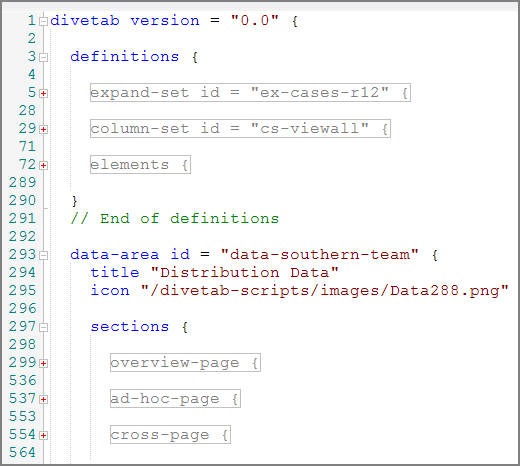DiveTab scripts, also referred to as modules, define a portion of the DiveTab application that includes the menu, data, document, repository, and web page areas. When you develop a DiveTab application, you create scripts to define how the information is accessed and displayed. A DiveTab application can use one or more DiveTab scripts. One primary script, usually with a menu area, is specified as the starting point or landing page.
Each DiveTab script starts with a top-level divetab tag to identify the file as a DiveTab script. The divetab tag includes a version string attribute followed by a set of braces.
divetab version = "0.0" {
...
}
Between the open and close braces, various tags, one per line, define the application. The development process includes the use of both GUI and text editors. A DiveTab script is saved with the file extension divetab.
A DiveTab script can be categorized into the following major blocks:
- Menu Area Block—Contains tags to define menu buttons.
-
Definitions Block—Contains tags that can be used by multiple data pages.
These include tags for Column Sets, Expand Sets, and Elements.
- Column Sets provide tags for setting up columns to be used for consistent data presentation on multiple pages.
- Expand Sets provide tags for defining a standard set of additional columns available to the end users.
- Elements contain the various tags for designing free-form areas for central and overview pages.
These tags can be included directly under a specific data page. However, by placing the tags under a Definitions block, they can be used by different data pages multiple times.
- Data Area Block—Contains the various data pages for analyzing data. Within the data area, data pages can be placed within a Sections or Pages block.
- Non-Data Area Block—Contains other content such as presentations, documents, and web pages.
Here is an example of a DiveTab script with ![]() key blocks collapsed.
key blocks collapsed.
DiveTab scripts use syntax that is similar to Spectre scripts.
See also:
- Creating the Initial DiveTab Module
- Typographical Conventions
- DiveTab Page Types
- Getting Started with DiveTab
- Scripting Syntax Elements
